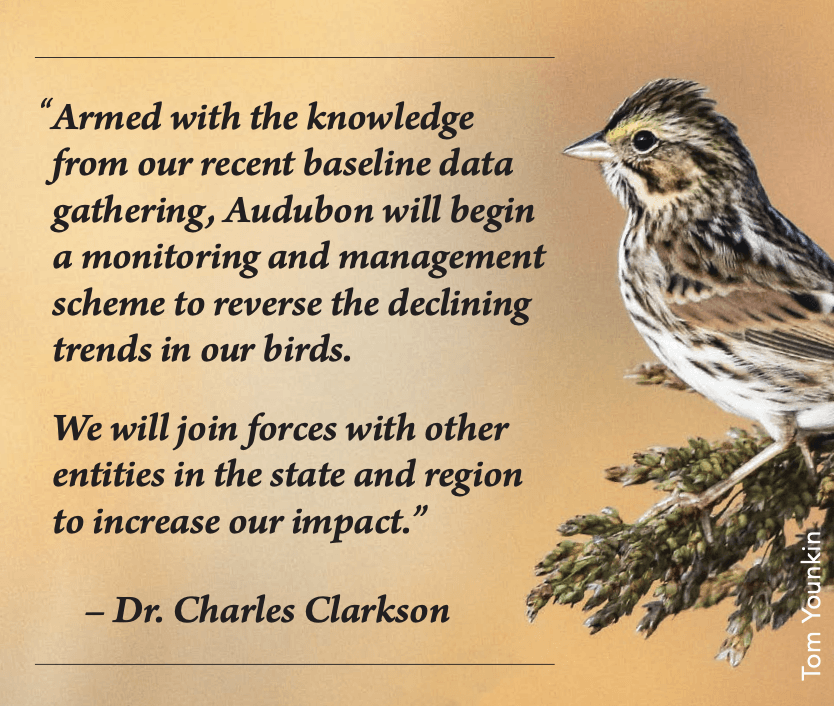Published on February 16, 2023
Change Happens Slowly...then All At Once
By Dr. Charles Clarkson
Increasingly dire warnings are met with even more inaction. This is how we lost the Passenger Pigeon (Ectopistes migratorius) from our skies and nearly lost the many species affected by DDT, including our national symbol, the Bald Eagle (Haliaeetus leucocephalus).
Take climate change as just one enormous example. Science has been fairly consistent with its messaging for decades: without changes to our consumption habits, we can expect our climate to become progressively more erratic. Not only will our climate be less predictable to us, it has already become less predictable to the other inhabitants of our world, causing many wildlife populations to decline precipitously due to increasingly mismatched predator-prey cycles.
A byproduct of living in “developed” countries has been the widening chasm between us and the natural world. We have largely removed ourselves from the ebb and flow of nature as we sit in our air-conditioned homes during the heat of the summer, or we crank our thermostat on a frosty winter morning. We spend a significant amount of our lives viewing our planet through a pane of glass, as we control our own environment. To a great degree, this separation between self and the natural world has fueled our ignorance to just how dire the situation has become. The average human has barely experienced the protracted but consistent changes that have occurred to our climate since we first flooded fields to plant agricultural crops and burned coal to generate electricity. To most of us, the alteration of our habitats as they become choked with invasive species, the rapidly dwindling fresh-water supplies, the near crash in the ocean’s productivity, or the countless other changes that have occurred to our planet in a geologic blink of an eye are issues known to us only from excerpts we digest from our digital devices as we sit in homes, offices, restaurants or coffee shops.
Recently, the first comprehensive report detailing the distribution, habitat-selection and population trends of the birds utilizing The Audubon Society of Rhode Island’s wildlife refuges was released. This report, titled “The State of Our Birds”, represented the culmination of a year-long data collection scheme that involved over 80 volunteers, trained ornithologists, months of data entry and analysis, and a great deal of writing and editing. Putting together this report was, to be blunt, a very sobering experience. As the data came into focus only to show a nearly universal declining trend in species that breed or overwinter on our refuges, the task of conserving these natural resources seemed overwhelming. Every group Savannah Sparrow (Passerculus sandwichensis) of birds, from those found in shrubby habitats and grasslands to those that reside in wetlands or eat insects on the wing, are declining. Even birds most commonly associated with human-modified landscapes, such as pigeons and starlings, are experiencing steep reductions in population size.
And these are not declines that have taken lengthy periods to occur. Population trend data were calculated from the years of 1966–2019, a period of only 53 years. For reference, the average life expectancy in the United States is 77 years. In less than a single human lifetime, 34% of the bird species breeding in Rhode Island have declined, and some of these declines have been dramatic. Along the Mid-Atlantic, Chimney Swift (Chaetura pelagica), Brown Thrasher (Toxostoma rufum), Prairie Warbler (Setophaga discolor), Eastern Towhee (Pipilo erythrophthalmus), Black-and-white Warbler (Mniotilta varia), Wood Thrush (Hylocichla mustelina), Field Sparrow (Spizella pusilla) and Common Grackle (Quiscalus quiscula) populations are less than half of what they were just 53 years ago…to cite just a handful of examples.
The time to start patching the leaks in our roof is now. Placing buckets under each leak to simply catch the water will no longer do. Buckets only buy us time, they do nothing to stop the damage. They still fill and overflow. Many of the birds experiencing decline are still considered species of “least concern” as their global populations are large or they occupy expansive geographic ranges. However, make no mistake, inaction now will only lead to catastrophe. The pace of conservation is slow. Considering the time and effort it takes to bring species back from decline, a population that is half of what it was just five decades ago should very much be of great concern.
Armed with the knowledge from our recent baseline data gathering, Audubon will begin a monitoring and management scheme to reverse the declining trends in our birds. We will join forces with other entities in the state and region to increase our impact. We will not place species on a spectrum of conservation concern. If there are things we can do to positively impact our birds, regardless of their conservation status, we will do them. After all, the mission of the Audubon Society of Rhode Island is to protect all birds, not just those species that need help the most. I am not ok with having fewer birds in my life. You shouldn’t be either.
Dr. Charles Clarkson is the Director of Avian Research with the Audubon Society of Rhode Island


















